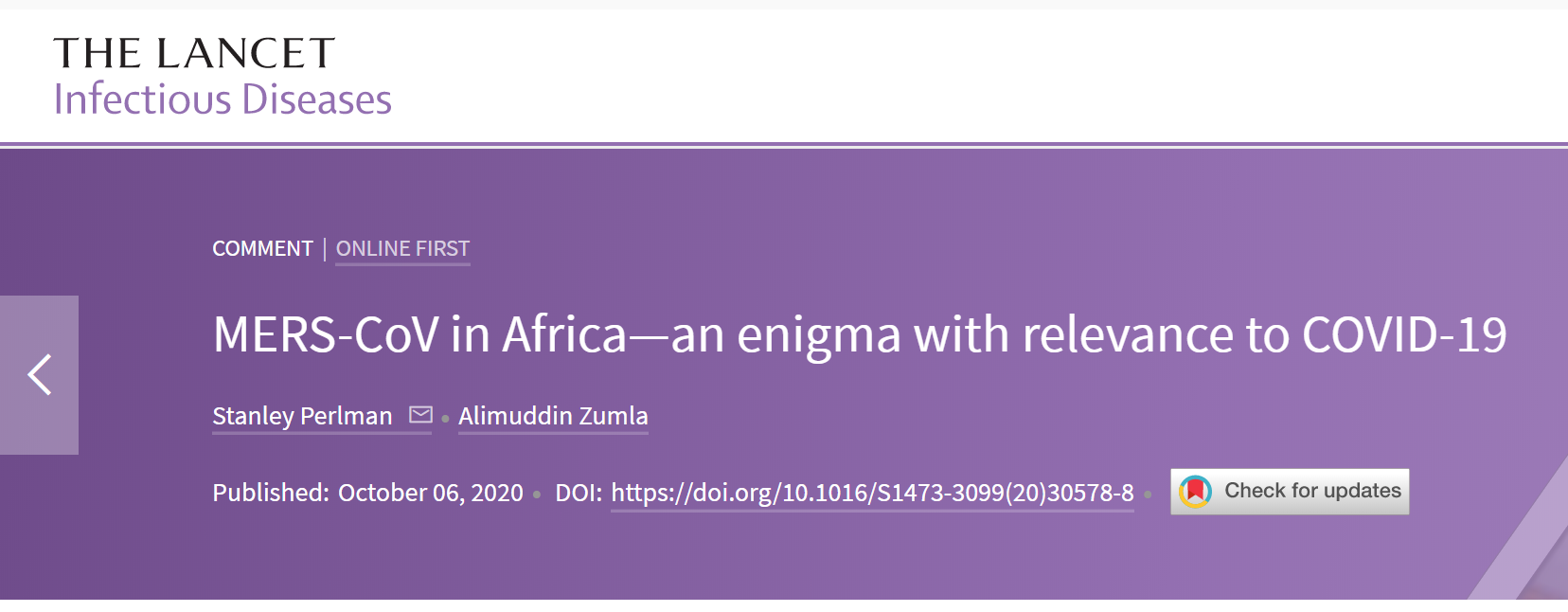The Team Led by Professor Jin Cunzhao of SKLRD Takes the Initiative to Reveal the MERS-CoV Infection of Those in Close Contact with African Dromedary
2020-10-061509The team led by Professor Jincun Zhao from the First Affiliated Hospital of Guangzhou Medical University/The State Key Laboratory of Respiratory Disease cooperated with the team led by Professor Malik Peiris from Pasteur Institute of the University of Hong Kong to detect the peripheral blood of those in close contact with dromedary of Nigeria, Africa to study the MERS-CoV specific T cell responses. They discovered that the infection rate of MERS-CoV among those in close contact with dromedary was near 30%. The research findings were published online in the top infectious diseases journal The Lancet Infectious Diseases on October 6.

Middle East Respiratory Syndrome (MERS) was first found in Saudi Arabia in 2012 and spread rapidly to 27 countries and regions, and was imported into Guangdong Province in 2015. MERS-CoV and SARS-CoV, SARS-CoV-2 are known as three new highly pathogenic respiratory coronaviruses among people, and the MERS mortality rate is ranked the top, as high as 34.8%, which poses a great threat to global public health security. At present, serological methods are mainly used to monitor the prevalence of MERS-CoV in the population. The team led by Jincun Zhao found that in some MERS infected people with mild symptoms or no symptoms, their antibody response duration was very short, suggesting that the actual number of MERS cases may far exceed the statistical figure of WHO (Sci Immunol 2017). At present, it is believed that in addition to human-to-human transmission cases, MERS-CoV is mainly transmitted to people by dromedary of the Middle East to humans. Dromedary ownership in Africa accounts for nearly 70% of the world’s total, and more than 80% of the dromedaries are MERS-CoV serologically positive, but no MERS cases have ever been reported in Africa.
Zhao’s team and its partners collected blood samples from dromedary slaughterhouse workers, non-dromedary direct contact workers, and people far away from slaughterhouses in Nigeria, Africa, and used Chinese healthy volunteers as a control group. The research found that although the plasma samples of some people with close contact with dromedary had binding activity to S proteins of MERS coronavirus, no neutralizing antibodies were detected in all samples. Nevertheless, MERS-CoV virus-specific T cell responses were found in the blood of those with close contact with dromedary, while non-direct-contact and non-contact groups had no T cell responses to the MERS-CoV virus. An overall MERS-CoV infection rate of those with close contact with dromedary in Nigeria is approximately 30%. This implies that a large number of animal-derived MERS-CoV infections are existing among those with close contact with dromedary in Nigeria and other African regions.
Professor Stanley Perlman of the University of Iowa, an internationally renowned coronavirus scientist, was invited to give a review with The Lancet Infectious Diseases the same period. The review suggests that virus specific T cell response detection may be more sensitive than serological detection for the identification of previous MERS infections. Based on this method, it is inferred that the infection rate of MERS in Africa may have been underestimated all the time, but this conclusion still needs to be supported by the experimental data of a larger sample size in other regions of Africa. Moreover, due to the diversity of MERS-CoV branches and the actual situation of a large number of dromedaries infected by MERS-CoV in Africa, over time, adaptive mutations that are more conducive to cross-species transmission or human-to-human transmission may occur to the MERS-CoV, resulting in outbreaks. Research findings from Zhao’s team and their partners also have important guiding values for the diagnosis, detection, traceability and vaccine development of the COVID-19 pandemic. COVID-19 is similar to MERS, where antibody responses to mild and asymptomatic infections are also short, while virus-specific CD4+ or CD8+ T cell responses can be used as a more sensitive and efficient detection method for assessing past / existing infections due to their longer duration, which is complementary to neutralizing antibody detection in evaluating the immune effect of a vaccine. The study also provides guidance for vaccine development for MERS and COVID-19: inducing virus-specific T cell responses may help prolong protective effectiveness of vaccines.

Professor Jincun Zhao and Professor Malik Peiris are co-authors of this paper. Dr. Mo Jiabin (Chris Ka Pun Mok), Dr. Airu Zhu and Professor Jingxian Zhao of the First Affiliated Hospital of Guangzhou Medical University / State Key Laboratory of Respiratory Disease are co-authors of this paper. The project has been funded by the National Science and Technology Major Project (2018 ZX10101002), the National key R & D Program (2018 YFC1200100), the National Natural Science Foundation of China for International Cooperation and Exchange (8181101118) and other projects.
Link of the full article:
https://www.thelancet.com/journals/laninf/article/PIIS1473-3099(20)30599-5/fulltext#%20
Link of the review:
https://www.thelancet.com/journals/laninf/article/PIIS1473-3099(20)30578-8/fulltext
















